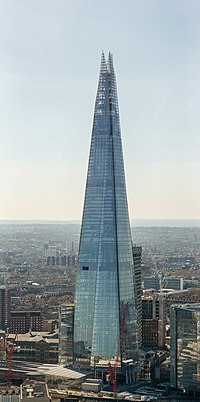
Photo from wikipedia
Purpose This paper aims to present the findings of a numerical investigation into the performance of the steel-concrete composite floor involved in Broadgate Phase 8 fire. Design/methodology/approach The investigation is… Click to show full abstract
Purpose This paper aims to present the findings of a numerical investigation into the performance of the steel-concrete composite floor involved in Broadgate Phase 8 fire. Design/methodology/approach The investigation is conducted by carrying out a 3-D thermomechanical analysis of a composite floor similar to the one involved in the fire using ANSYS. Four fire scenarios are investigated, with each producing a unique stress – strain pattern. The results obtained are compared with the observations made after the fire and inferences drawn. Findings The results obtained are found to be correlated with the observations made after the fire. The performance of the composite floor is found to be dominated by development of large strains, leading to large deflections. Furthermore, colder parts of the structure, through redistribution of forces, are found to have a profound impact on the ability of a composite floor to resist heating effects. From the findings, it is concluded that connections’ design, occurrence of membrane action and thermal restraints were the key reasons the floor did not fail. Originality value The study takes a more forensic approach. This is a departure from majority of published literature, where comparison is usually between experimental and numerical results. By comparing the findings from a real fire with those of a numerical investigation, the study provides an insight into the accuracy of applying numerical models for the prediction of effects of fire on structural behaviour.
Journal Title: Journal of Structural Fire Engineering
Year Published: 2017
Link to full text (if available)
Share on Social Media: Sign Up to like & get
recommendations!